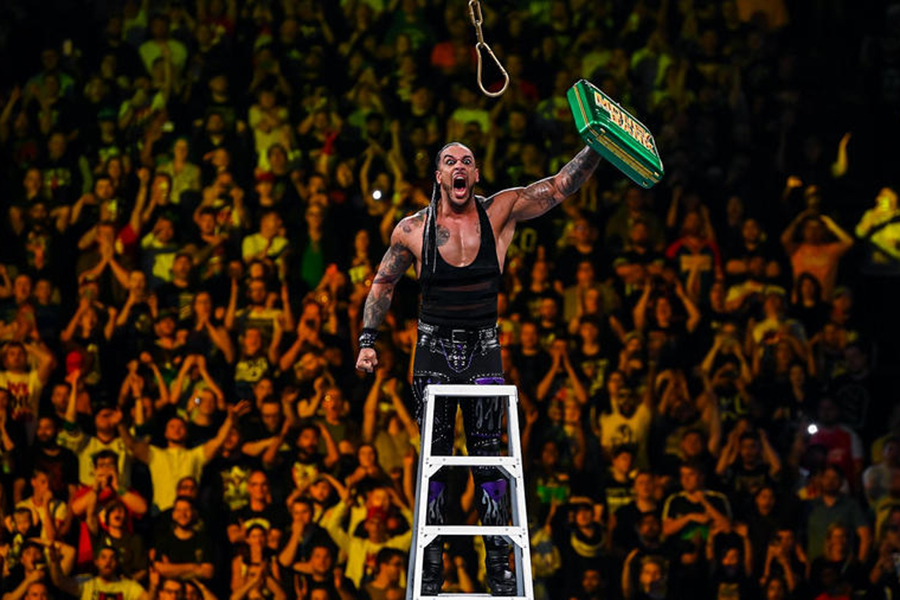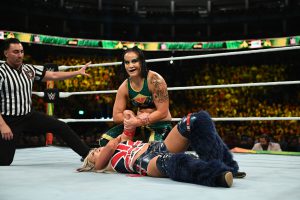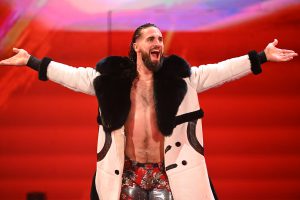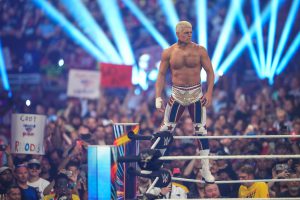Deeper Look: WWE creating its own rock and roll universe

Damian Priest, courtesy WWE.
SAN FRANCISCO — Seth Rollins stands at the center of the ring set up on the floor of Chase Center, arms spread wide, and his head held high, slightly tilted. He’s just come up victorious in defending his heavyweight title against challenger “The Miz” in the main event at this WWE SuperShow in early October.
WWE Survivor Series: WarGames
5 p.m., Saturday, Nov. 25
Peacock (Streaming)
WWE Road to WrestleMania
7:30 p.m., Saturday, Feb. 17
Oakland Arena
Tickets: $32 and up.
Without prompting, the gathering of thousands of pro wrestling fans knows exactly what to do, singing the rise and fall of “ooo-WAH-OOO-ooo’s” of Rollins’ theme song, “Visionary.” It’s a simple yet memorable hook that’s instantly recognizable even if you know nothing about Rollins or his superstar persona. Fans power up the lights of their phones to illuminate the dark arena, waving them back and forth the rhythm. There’s no better example of the role music plays in professional wrestling.
Each WWE Superstar—the official names for the competitors—has his or her own theme song. Those anthems define their personality just as much as their tights, their mannerisms and the way they interact with the crowd. If you’re a “Face” (one of the good guys), you probably have something energetic, urgent, soaring and loud. If you’re a “Heel” (a villain), it’s probably a slow-churning, brooding tune—but still heavy and loud.
Some matches aren’t cut-and-dry, but the Chase Center event was a prime example of wrestling at its most distilled form. The crowd cheered on the favorites, who provided a rah-rah of energy in turn, while jeering the bad guys who hurled insults right back.
What makes music central to everything is that it’s the first sign that a Superstar is entering the arena and it should immediately ignite raucous cheers or raging boos within the first handful of notes The best songs are instantly recognizable so that the crowd responds right away. While the ultimate energy from the crowd is cultivated by what happens in the ring, the music is what creates the tension, builds the energy and sets the tone for what’s to come.
Wrestler and former mixed martial arts fighter Shayna Baszler said her entrance song was inspired by KISS’ “God of Thunder,” a version of which (by metal band Excruciation) she used to use in her MMA days. She sent that to WWE’s music department (WWE Music Group), which wrote her a song with a similar feel.
“When I walk into the ring, I look at that as a march to battle,” Baszler said in a video interview a few weeks later.
The 43-year-old, who earned the nickname the Queen of Spades as an MMA fighter, said she started playing music when she was 6—the same age she started amateur wrestling—and that music in wrestling works the same way it does in movies. “Music makes or breaks a scene sometimes. … The entrance music really sets the tone for what’s going to happen.”
It’s also a big part of training, Baszler added. On weightlifting days, she prefers discordant and abrasive metal, like Bolt Thrower and Amon Amarth. “I need to get angry and throw some weight around,” she said. When she’s grappling or training with a heavy punching bag, she prefers music that she can groove to, by the likes of Priestess, Machinehead or Run the Jewels.
“There’s a lot more footwork,” she said. “I like a little bit of rhythm and I like my mind to go blank when I’m grappling.”
Sometimes the music isn’t about opening a match but about interrupting one. Take the Street Fight between “The American Nightmare” Cody Rhodes and Damian Priest. Midway through the match, the tide turns, when wrestler Jey Uso arrives unannounced. Still, his theme “Main Event Ish” hits right away and fans immediately rise to their feet knowing that things are about to take a turn. Uso ultimately helps Rhodes win his match, but that moment of his arrival helped build the spark of energy for the end of the match.
In some cases a piece of music that fits the personality of the wrestler. Other times, the connection is to a music artist. Rhodes’ theme song is “Kingdom” by Downstait. Bad Bunny performed during 2021’s Royal Rumble. Rock singer-songwriter Poppy released an entire soundtrack for WWE developmental offshoot NXT (along with Raw and Smackdown). Rock guitarist Nita Strauss has been called in to perform at Wrestlemania and has a recurring gig with WWE. Pay-Per-View events are also often tied in with a specific theme song.
“For Wrestlemania, these big pay-per-views, they like to get here big artists in,” Baszler said, pointing out that even Joan Jett has performed live as UFC legend Ronda Rousey made a WWE appearance.
For WWE’s annual Halloween Havoc shows this year, rock band New Years Day performed single “Vampire” in one episode and then debuted a new song in the next.
The band had previously performed at NXT events before and singer Ash Costello even performed Superstar Rhea Ripley’s entrance theme at WrestleMania 37.
Some of the artists with which WWE has made ties have become synonymous with it events.
Otherwise, the music is all produced in-house by WWE Music Group. Most of the music played at the San Francisco house show fit into the latter category.
The battle between Bronson Reed and Otis was a prime example of music feeding the energy. The match pitted two heavyweights against each other with Reed at 6 feet and 330 pounds, and Otis at 5 feet 10 inches, and 330 pounds. That’s two big boys, to the say the least. Reed’s song is heavy brooding rap-rocker “Battle Tested,” a beat-heavy stomper with a siren blaring in the background. It’s the perfect combination of drama and heaviness for Reed to lumber his way to the ring. For Otis, soaring, patriotic anthem “Shooosh” invites the unorthodox big man to the ring. Ultimately, Reed would come out victorious.
RELATED STORIES:
• Fozzy leads a raucous roadshow at Great American Music Hall
• Kate Nash returns with new album and new season of hit show
This non-televised “house” show at Chase Center offered a glimpse of the WWE with a display of athleticism without the pressures of fitting into the box and format of a televised broadcast. To some degree, a fan could enter the arena without any prior knowledge of the Superstars or storyline context and immediately be immersed in the action. The ingredient that helps tie all of those emotions together is the music that feeds the energy for fans and wrestlers alike.
Editor Roman Gokhman contributed to this story. Follow writer Mike DeWald at Twitter.com/mike_dewald.




